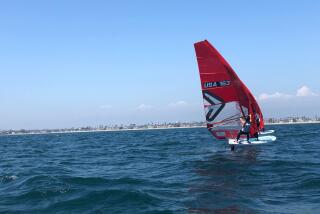AMERICA’S CUP UPDATE : NOTEBOOK : Competition Knows Kiwi Keels Help, but How Do They Work?
- Share via
SAN DIEGO — Overheard on the New Zealand boat:
“Hit the elevator . . . watch the squeeze!”
The worst-kept secret around San Diego is that the Kiwi boat has tandem, fore-and-aft keels, supporting a ballast bulb below them. What isn’t known is exactly how they work.
Do the entire fins rotate, as did those on Challenge Australia? Or just trim tabs on the trailing edges?
Spirit of Australia and all of the remaining teams also have experimented with tandem keels, but none with the success of New Zealand. All Stars & Stripes did was go sideways.
But it’s been noted lately that the Kiwis seem to be able to sail higher into the wind for brief spurts--as Louis Vuitton Cup media director Bruno Trouble noted in one his daily race summaries this week: “. . . the ability to outpoint any of its opponents when needed. “
Especially in the last race against Il Moro di Venezia, which New Zealand will meet in the challenger finals starting April 19, the Kiwis were totally stuffed below the Italians at the start but simply sailed out from under and into the lead--an incredibly difficult thing to do in sailboat racing.
A guess is that the “elevator” is the cockpit adjustment to the keel that allows the boat to point higher for a time, and the “squeeze” is the result in pinching off an opponent to take control.
Some of the crew of Stars & Stripes is not keen on the suggestion by ACOC president Malin Burnham that if Bill Koch gets two boats in the finals, he should have them sail one to give A3 the best competition before the Cup match in May.
Port trimmer and operations manager Bill Trenkle said, “How hard do you think someone could sail knowing they didn’t have any chance of getting in (the match) themselves?”
Nance Frank, skipper of the U.S. Women’s Challenge, takes exception to Dennis Conner’s announcement that his 1993-94 Whitbread Round-the-World Race effort “may be the only U.S. entry.”
“How dare he say (that)?” Frank said by phone from Annapolis, Md., after Conner announced his plans Thursday. “He can’t say he’s the only American entry. There are 15 this time--not just Dennis.”
Frank was the only U.S. entry with an all-woman challenge in ‘89, but when funding fell through the day before the race was to start she and her crew were able only to sail across the starting line with the other boats before returning to port at Southampton, England.
“We’re the only one that’s been out training for four years,” Frank said.
She and what she calls a “core crew” have competed in events in Russia, Australia and on both U.S. coasts. The Whitbread consists of six legs over 31,975 nautical miles, but Conner indicated he would sail on only one or two of the warmer passages.
“He’s not even going to do the whole race,” Frank said. “He’s just going to line his own pockets.”
What does the Cup mean to New Zealand?
The magazine New Zealand Yachting notes that “the All Blacks fell to the Wallabies in the Rugby World Cup . . . (and) the cricketeers . . . shone through to the semis only to suffer the heartbreak of unlikely defeat by Pakistan. All eyes are on the New Zealand yachtsmen to break the semifinal bogey and proceed on to America’s Cup glory.”
New Zealand sailors separated by the Cup will be reunited for the Olympics.
Sailmaker Tom Schnackenberg--Rod Davis’ brother-in-law--worked for Spirit of Australia but will return as coach and technical adviser. John Cutler, Chris Dickson’s tactician aboard Nippon, will be the Finn class coach. Davis, who holds dual U.S. and New Zealand citizenship, will sail a Soling for New Zealand at Barcelona.
The Kiwis’ Soling and Star class coach will be Vince Brun, who has been mainsail trimmer on Stars & Stripes.
More to Read
Sign up for The Wild
We’ll help you find the best places to hike, bike and run, as well as the perfect silent spots for meditation and yoga.
You may occasionally receive promotional content from the Los Angeles Times.






